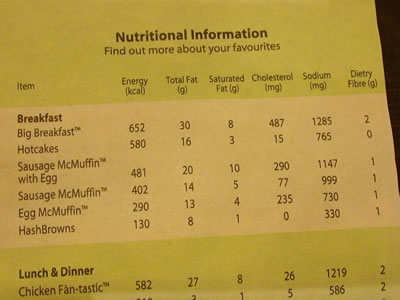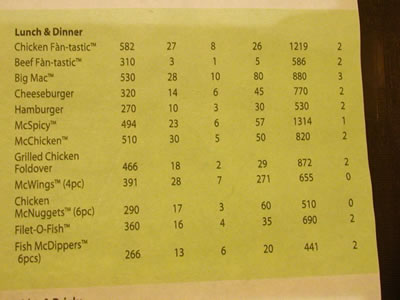From the Strait Times two days ago:
McDonald's takes healthy bite with nutrition labels
All its food to carry such labels by mid-2006; also more balanced choices coming
By Krist Boo
BIG Macs - and all other McDonald's food sold here - will carry labels detailing their nutritional value by the middle of next year. The move by the fast-food giant in Singapore is part of a healthy-image makeover the Golden Arches is undergoing globally.
The burger chain said last month that by the end of next year, two-thirds of its 30,000 restaurants worldwide would label the fat, salt, calorie and carbohydrate content of its food. McDonald's revealed its Singapore labelling deadline as it launched two new offerings - Asian-style chicken and beef rice burgers...
The Health Promotion Board (HPB), which is working with the fast-food chain on providing nutritional education, hopes McDonald's will not only indicate nutritional values but that it would also help consumers make sense of it. A label that indicates an item has 400 calories, for instance, is helpful only if it explains that 400 calories make up almost half a day's calorie needs, it said...
The interesting thing about the title is that nutrition labels, per se, don't make the food any more, or less, healthy. Second thing is that since I like Big Mac meals, I've decided to read up on what the numbers mean.
Here's what you'll find on the tray.



The first column shows
kcal, or
calories. This is the amount of energy that's released when foods are digested.
When the supply of energy—that is, the number of calories consumed in foods—exceeds the body's immediate needs, the body stores the excess energy. Most excess energy is stored as fat. Some is stored as carbohydrates, usually in the liver and muscles. As a result, weight is gained. An excess of only 200 calories per day for 10 days is likely to result in a weight gain of nearly ½ pound, mostly as fat. Source.
Health Promotion Board has a
list containing some estimates of daily allowances. I probably need around 2800 cal?
The second column shows total fat.
These complex molecules are composed of fatty acids and glycerol. Fats are the slowest source of energy but the most energy-efficient form of food. Each gram of fat supplies the body with about 9 calories, more than twice that supplied by proteins or carbohydrates. Because fats are such an efficient form of energy, the body stores any excess energy as fat. The body deposits excess fat in the abdomen (omental fat) and under the skin (subcutaneous fat) to use when it needs more energy. The body also stores excess fat in blood vessels and within organs, where it blocks blood flow and damages the organs, often with devastating results...
Authorities generally recommend that fat be limited to less than 30% of daily total calories, or fewer than 90 grams per day, and that the amount of saturated fat, trans fatty acids, and cholesterol in the diet be reduced. However, people with high cholesterol levels may need to reduce their fat intake even more. When fat intake is reduced to 10% or less of daily total calories, cholesterol levels tend to decrease dramatically. Source.
So how should we make sense of this number? Let's choose my favourite Big Mac. Two all-beef-patties-special-sauce-lettuce-cheese, pickles-onion-on-a-sesame-seed-bun contains 28g of fat. 28 multipled by 9 is 252; the Big Mac has 252 calories of energy in the form of fats. So this constitues how many percent of my daily allowance? 252 divided by 2800 is 9%. Phew, I'm well below the recommended 30%.
But wait, there's more! I'm assuming an allowance of 2800 calories because this is the figure given by the HPB. In reality, I may have only consumed a much lower amount of calories. For example, I missed my lunch yesterday. Assuming I only had 1400 calories, the calories-from-fat number would be 252/1200 = 20% of my daily intake! But wait again, there's more yet! I'm only calculating for a single Big Mac. I always have the Big Mac
meal (no upsize, thank you) that has 44g of fat, so if I take that into account, the figure will be 14% (for 2800-cal diet) to 20% (for 2000-cal diet) . Essentially, I'm not supposed to consume not much more fat for the rest of the day. (On McDonald's US
website, the numbers are more conservative. They assume the typical person takes in 2000 calories per day.)
You can find a fun-to-use
nutrition calculator from McDonalds Singapore. However, ignore the pie chart at the bottom of the numbers. There seems to be an error in the programming script; the resulting chart is almost certainly wrong. Maybe they'll correct it when they next revise the page.
I'm not exactly sure what to do with the Cholesterol number. From
this FDA website, it seems that the daily allowance for Cholesterol (and I'm not sure whether this is refering to the good or bad kind) is 300mg.
For the sodium (I think it's found in salt), according to
Merck, the daily limit is 1000mg. Just look at the Sausage McMuffin with Egg, my favourite. It has 1147mg of sodium!
The last number is fibre. The Big Mac has 3g of fibre.
Authorities generally recommend that about 30 grams of fiber be consumed daily. In the United States, the average amount of fiber consumed daily is about 25 grams. An average serving of fruit, a vegetable, or cereal contains 2 to 4 grams of fiber. Source.
So these are some superficial things I've learnt from the nutritional labels. Your mileage will vary. Note that I'm not a trained nutritionist (obviously!), so please take things with a pinch of sodium.
And have a great and nutritious New Year!
Update (!): Heavenly Sword has more
nutritious things to say!


 The first column shows kcal, or calories. This is the amount of energy that's released when foods are digested.
The first column shows kcal, or calories. This is the amount of energy that's released when foods are digested.
1 comment:
Have a brilliant & supremely nutritious year, Jeff! :)
Post a Comment